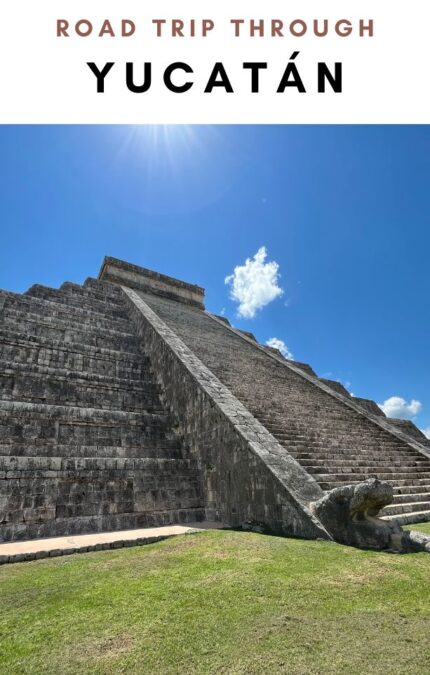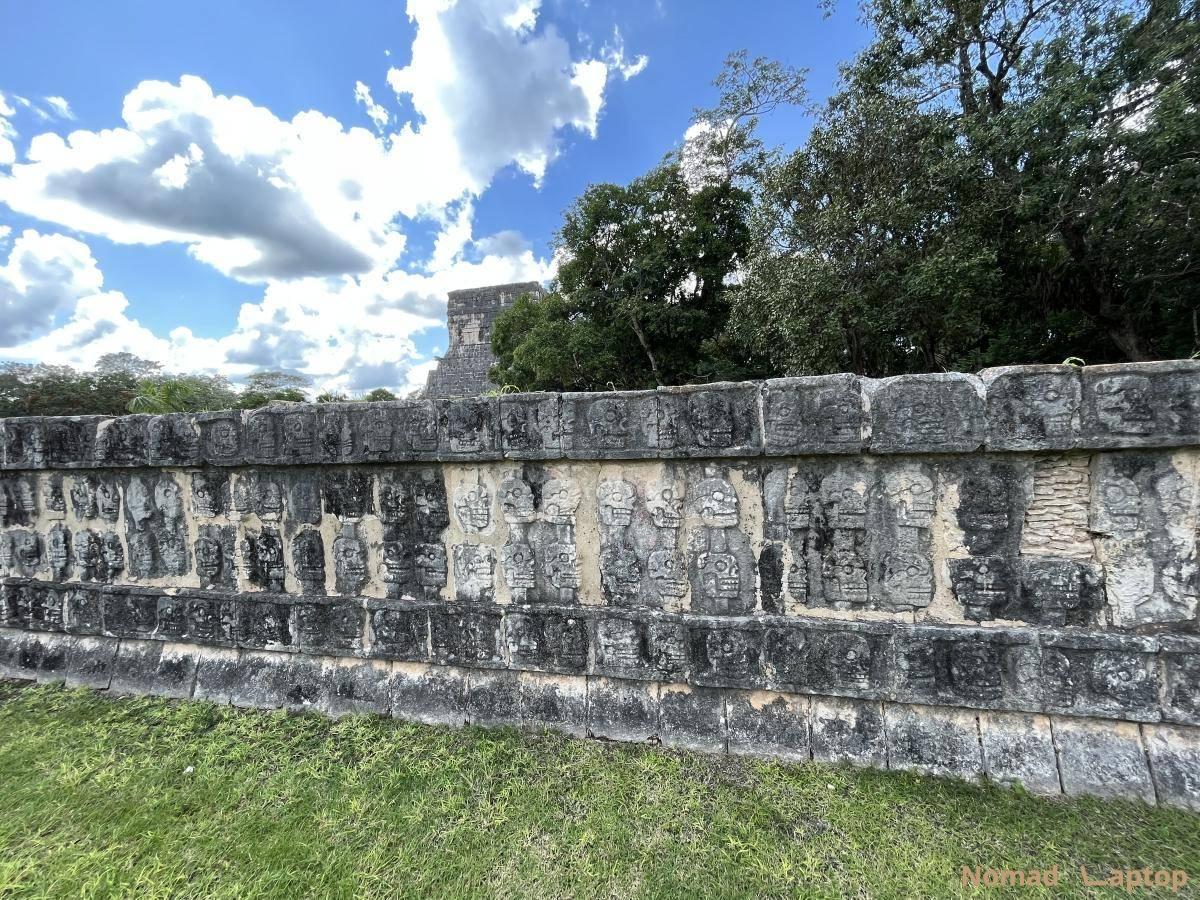Chichén Itzá is a Mayan sacred city that was built in the terminal classic period (9th to 12th century) in the Itza region, in the modern-day Yucatan state of Mexico.
It is most known for the main pyramid, the Temple of Kukulkan, also known as El Castillo in Spanish, dedicated to the plumed serpent deity of Mayan mythology. The pyramid is synonymous with the entire complex of Chichen Itza and became part of the New Seven Wonders of the World in 2007 and a World Heritage Site by UNESCO in 1988.
It is the most known and well-preserved of the many Mayan archaeological sites and is also one of the few where the practice of human sacrifices can be clearly seen. This can be seen in the stone carvings depicting skulls, the two sacred cenotes where the sacrifices took place, and the Ball Court, the largest in Mesoamerica, where the ball games often ended in decapitation as a ritual offering to Kukulkan and Chaac, the god of rain. All this makes Chichen Itza fascinating to explore and a must-visit on any trip to Mexico.
For more information, check out this article on my Mexico Road Trip
Basic info
The most visited and well-known city and central pyramid of the ancient Mayan world.
A relatively small site packed with all the fascinating aspects of ancient pre-Columbian civilizations, from architecture to astronomy, date keeping, mythology and human sacrifices, ball games, and more
About
Chichen Itza is a pre-Columbian city built by the Maya people of the terminal classic period. It is one of the last large settlements in the Mayan world, and its ascension roughly correlates with the decline of other major Mayan centers.
The sacred city is located 120km east of Merida or 200km west of Cancun and covers an area of approximately 10 square kilometers.
Chichen Itza was a major focal point in the terminal classic and postclassic periods and was considered one of the Tollans – the mythical great cities referred to in later Mesoamerican literature.
Trivia pill
In the Mayan language, the name Chichén Itzá is compounded by the words chi (mouth), Chen (well), and Itza (of the witch water). It is believed that the location of the city was chosen for its proximity to two large cenotes (natural water wells) where people would be thrown in as sacrifices. Those who survived were believed to be seers, hence the last part of the name Itza.
Getting there
The easiest way to reach Chichen Itza is by flying to Cancun and then taking a tour bus or renting a car and driving there. The closest large city is Valladolid, which is a great stop as it is famous for the large number of cenotes, some found directly in the city. It is best to dedicate a full day to exploring the site as well as taking a dip in the nearby cenotes, such as Cenote IK Kil.
Trivia pill
If you can plan a visit during the spring equinox, you can witness the descent of Kukulkan. The Mayans are well known for their astronomical and date-keeping expertise, and during the equinoxes, the setting sun shines on the main pyramid, and each step creates a shadow that, as a whole, resembles the plumed serpent Kukulkan, the snake deity walking down the pyramid.
Prices
Entrance Tickets
Ticket prices differ between locals and international tourists and adults and children. For international visitors, the prices are $533 MXN for adults and $80 MXN for children, as per the table below. Additionally, there is a night light show called “Kukulkan Nights” for $600 MXN.
Being the most well-known and visited archaeological site in Mexico, I recommend getting skip-the-line tickets beforehand, which can be found at the following link:
Entrances & Getting around
There is a single entrance to the site. The entire complex can be visited by foot in around 3 hours, but it can clearly be enjoyed for longer, especially if stopping at the many (many many) vendors selling souvenirs scattered all around.
The Site

All eyes and attention are clearly on the main El Castillo, or Temple of Kukulkan, which, despite being relatively short, does have an imposing presence on the whole area. Its construction is heavily based on timekeeping references, as it is well known that the Mayans were maniacal (“maya-cal?”) when it came to their calendars and timekeeping. The 4 sides represent the seasons; the 91 steps climbing each side add up to 364 (plus the top central chamber); the larger steps of the pyramid are 9, and if considering the central staircase that splits them, they become 18, as the number of months in their “non-sacred” calendar. It is also considered a reference to the nine nights and the nine gods that rule them. I did not catch or see any references to the numbers 13 and 20, which were of high importance to them, but I could have probably missed some details.
Speaking of calendars, the non-sacred calendar has 18 months and 20 days, which does not add up to 365. So they had an additional month made up of five “nameless days”—unlucky days where the barriers with their nine underworlds would dissolve. I really like this. We should also have this in modern times. After all, with all the leap years (and being a computer scientist, I have to add the infamous leap seconds), our Gregorian calendar is also a construction. We should have a week of “shit hits the fan” days. A sort of prolonged Halloween. It would certainly make us appreciate the passage of time more than a New Year’s eve filled with wishes and partying.
The main pyramid was built not only with references to astronomical coordinates and timekeeping aspects but acoustics as well. The famous “Chichen Itza Chirp” occurs in response to loud claps done at the base of the pyramid, which echo back from the top chamber down through the stairs, resembling a ghostly bird chirp. If done repeatedly, it really sounds like birds. Because of this, one can imagine the sheer amount of noise made by large tour groups when their guide explains this to them, making the entire place a big, noisy playground mess.
Anyway, in the complex, there is also the largest and best-preserved ball court in all of Mexico. The ancient Mayans were supposedly fond of playing this team game, where the rubber ball wasn’t supposed to touch the ground and could be controlled only through elbows, knees, and hips. These courts also have stone hoops on the two sides where the ball had to be thrown through using only hips. The whole court really felt like a stadium, were it not for the fact that the losing team’s captain would often be beheaded, as the game was actually used to manage disputes and a sort of confrontation between champions instead of going to war, rather than as entertainment.
Near the Ball Court is also the famous Wall of Skulls, a low ritual platform where the heads of those sacrificed in the Pok Ta Pok games would be displayed. wall has skulls carved into stone stacked side by side and on top of each other.
The complex has two cenotes: the natural sinkholes filled with water, which were seen as sacred by the ancient Mayans and are nowadays used as refreshing pools (not these ones, of course). The sacred cenote is impressive in the vertical drop of the sinkhole and becomes even more impressive when imagining the sacrifices that used to be performed there as offerings to the god Chaac. Several jewels, ceramics, and other riches, together with the remains of 200 bodies, were found at the bottom of the sinkhole when it was discovered.
The other main structure is the Temple of the Warriors behind the main pyramid. It is a large temple with many columns and statues. Unfortunately (and this goes for all buildings at Chichen Itza) visitors cannot enter it to see the many statues.
Another famous and iconic structure is El Caracol (meaning “the snail”), the observatory. Other than that, there are a dozen other structures and ruins of lesser importance and fame, such as the Osario (the Ossuary or the High Priestess Temple), the Church and Nunnery,
Best time to visit
Season
As with the rest of Mexico, November to April is the best time to visit, avoiding the rainy season and enjoying a drier climate.
The descent of Kukulkan
As mentioned above, there are two days when visiting Chichen Itza is particularly sought after and these are the spring and autumn equinoxes, when the sunset light creates shadows on the steps of the main pyramid, resembling the serpent deity Kukulkan descending from the stairs.
Opening hours
Chichen Itza is open from Monday to Sunday, from 8:00 to 17:00. Note that the last entrance/access is at 16:00
Guides & tours
Chichen Itza can be visited without a guided tour. There are a handful of buildings, and preparing and knowing about them beforehand is enough to enjoy the site. That being said, there are clearly many guided tours on-site or from the nearby cities of Merida and Cancun, which offer all-inclusive packages. One reference for these tours can be found here at chichenitzatours, or you can check out the offers below.
Offers for Chichen Itza
Weather
The weather in Chichen Itza is not the best in the sense that it is often humid and partly cloudy. The main structures are all placed in open fields; therefore, you will find yourself constantly under the sun except when moving from one building to another. All the better reason for closing your visit with a dip in a nearby cenote.
Clothing/Gear
No matter the season, the sun shines almost always during the day, so light clothes, hats, and sun cream are a must. Be sure to also bring plenty of water.
In the evening hours, the ever-present mosquitoes can also be a nuisance, so insect repellent is a good idea if you plan to stay until closure or go to the night show.
The complex is flat, so there isn’t any hiking involved, but there is quite some walking to do, so comfortable shoes are also important.
The use of drones is not allowed, and other professional photography equipment needs a permit from the Instituto Nacional de Antropología e Historia (INAH).














